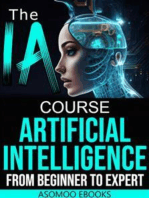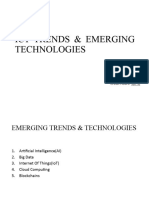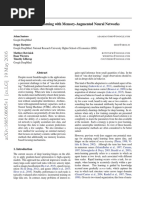0 ratings0% found this document useful (0 votes)
23 viewsWorkineh Amanu Section 4
Workineh Amanu Section 4
Uploaded by
workinehamanuThis document contains an assignment submission from a student named Workineh Amanu for an Emerging Technology course. It addresses 5 questions on topics like artificial intelligence, machine learning, deep learning, disciplines contributing to AI and HCI, barriers to adopting emerging technologies, types of cloud computing, and how technologies like nanotechnology, artificial intelligence, biotechnology, blockchain, and computer vision could shape the future. The student provides detailed answers for each question in the assignment.
Copyright:
© All Rights Reserved
Available Formats
Download as PDF, TXT or read online from Scribd
Workineh Amanu Section 4
Workineh Amanu Section 4
Uploaded by
workinehamanu0 ratings0% found this document useful (0 votes)
23 views17 pagesThis document contains an assignment submission from a student named Workineh Amanu for an Emerging Technology course. It addresses 5 questions on topics like artificial intelligence, machine learning, deep learning, disciplines contributing to AI and HCI, barriers to adopting emerging technologies, types of cloud computing, and how technologies like nanotechnology, artificial intelligence, biotechnology, blockchain, and computer vision could shape the future. The student provides detailed answers for each question in the assignment.
Copyright
© © All Rights Reserved
Available Formats
PDF, TXT or read online from Scribd
Share this document
Did you find this document useful?
Is this content inappropriate?
This document contains an assignment submission from a student named Workineh Amanu for an Emerging Technology course. It addresses 5 questions on topics like artificial intelligence, machine learning, deep learning, disciplines contributing to AI and HCI, barriers to adopting emerging technologies, types of cloud computing, and how technologies like nanotechnology, artificial intelligence, biotechnology, blockchain, and computer vision could shape the future. The student provides detailed answers for each question in the assignment.
Copyright:
© All Rights Reserved
Available Formats
Download as PDF, TXT or read online from Scribd
Download as pdf or txt
0 ratings0% found this document useful (0 votes)
23 views17 pagesWorkineh Amanu Section 4
Workineh Amanu Section 4
Uploaded by
workinehamanuThis document contains an assignment submission from a student named Workineh Amanu for an Emerging Technology course. It addresses 5 questions on topics like artificial intelligence, machine learning, deep learning, disciplines contributing to AI and HCI, barriers to adopting emerging technologies, types of cloud computing, and how technologies like nanotechnology, artificial intelligence, biotechnology, blockchain, and computer vision could shape the future. The student provides detailed answers for each question in the assignment.
Copyright:
© All Rights Reserved
Available Formats
Download as PDF, TXT or read online from Scribd
Download as pdf or txt
You are on page 1of 17
COLLEGE OF BUSINESS AND ECONOMICS
EMERGING TECHNOLOGY ASSIGNMENT
BY: Workineh Amanu
Id. No. UGR /7981/16
Section: 4
SUBMIT TO: HABTAMU ABUNE
Mar 6, 2024
Que 1. Compare and contrast Artificial Intelligence, Machine learning, and
deep learning.
Que 2. List and discuss at least four disciplines that contribute to AI and
HCI. (Common for both
AI and HCI)
Que 3. Discuss barriers to adopting Emerging Technology.
Que 4. Briefly discuss the different types of Cloud Computing. Discuss the
different technologies that contribute to cloud computing.
Que 5. Briefly discuss the following emerging technologies and how it
could be shaping the future of you and your business or professional:
A. Nanotechnology
B. Artificial intelligence
C. Biotechnology
D. Block chain technology
E. Computer vision
The Answers of the above Questions are listed below respectively.
Ans1
Artificial Intelligence
• Artificial intelligence, commonly referred to as AI, is the process of
imparting data, information, and human intelligence to machines.
• The main goal of Artificial Intelligence is to develop self-reliant
machines that can think and act like humans. These machines
can mimic human behavior and perform tasks by learning and
problem-solving. Most of the AI systems simulate natural
intelligence to solve complex problems.
• AI is a field of study that combines the concept of computer
science and the use of datasets to solve problems in many use
cases with minimal human intervention
Machines learning
• Machine learning is a discipline of computer science that uses computer
algorithms and analytics to build predictive models that can solve
business problems.
• Machine learning is based on algorithms that can learn from data
without relying on rules based programming.
• Machine learning is a subset of artificial intelligence (AI) in which we use
a specific algorithm to process data such that we can use the algorithm
to predict the value of unseen data. However, the algorithm that we use
in machine learning is designed in such a way that it needs little
intervention from us as a programmer.
Deep learning
• Deep learning is a subset of machine learning that deals with
algorithms inspired by the structure and function of the human brain.
• Deep learning algorithms can work with an enormous amount of
both structured and unstructured data.
• Deep learning’s core concept lies in artificial neural networks, which
enable machines to make decisions. The major difference between
deep learning vs machine learning is the way data is presented to the
machine.
• Machine learning algorithms usually require structured data,
whereas deep learning networks work on multiple layers of artificial
neural networks.
Ans2
Disciplines Contributing to HCI and AI
• The field of HCI and AI covers a wide range of topics, and its
development has relied on contributions from many disciplines.
Some of the main disciplines which have contributed to
HCI and AI are:
1. Computer Science
• Technology
• Software design, development & maintenance
• User Interface Management Systems (UIMS) & User Interface
Development Environments (UIDE)
• Prototyping tools
2. Cognitive Psychology
• information processing
• capabilities
• limitations
• cooperative working
• performance prediction
3. Language: focuses on the interaction between computers and human.
• languages, enabling machines to understand, interpret, and generate
human-like text.
• Language translation, sentiment analysis, speech recognition, chatbots.
4. Mathematics-is the study of numbers, quantities, shapes, patterns,
structures, and relationships. It is a fundamental tool for modelling and
understanding various phenomena in the natural and social sciences.
5. Philosophy- is a branch of knowledge that involves the study of
fundamental questions about existence, knowledge, values, reason,
mind, and language.
• Philosophers seek to understand and critically examine the nature of
reality and human experience. Computer supported cooperative work
(CSCW)
6. Computer Engineering: a discipline that combines elements of
electrical engineering and computer science. It involves the design,
development, and integration of computer systems and networks.
Ans3
Barriers to adopting Emerging Technology
• Lack of Sufficient knowledge
• Timing to make changes and adjust
• Lack ability to implement
• Lack of security concerns
• Budgetary priorities
• Resistance to learning new technology
• Work stress/overload
• high cost
Ans4
There are 4 types of Cloud Computing
1. Public cloud is open to all to store and access information via the Internet
using the pay-per-usage method. In public cloud, computing resources are
managed and operated by the Cloud Service Provider (CSP).
• Example: Amazon elastic compute cloud (EC2), IBM SmartCloud Enterprise,
Microsoft, Google App Engine, Windows Azure Services Platform
2. Private cloud is also known as an internal cloud or corporate cloud. It is used
by organizations to build and manage their own data centers internally or by the
third party. It can be deployed using Opensource tools such as Openstack and
Eucalyptus. Based on the location and management, National Institute of
Standards and Technology (NIST) divide private cloud into the following two parts
• On-premise private cloud
• Outsourced private cloud
3. Hybrid Cloud is a combination of the public cloud and the private cloud.
we can say: Hybrid Cloud = Public Cloud + Private Cloud
• Hybrid cloud is partially secure because the services which are running
on the public cloud can be accessed by anyone, while the services which
are running on a private cloud can be accessed only by the organization's
users.
Example: Google Application Suite (Gmail, Google Apps, and Google
Drive), Office 365 (MS Office on the Web and One Drive), Amazon Web
Services.
4. Community cloud allows systems and services to be accessible by a
group of several organizations to share the information between the
organization and a specific community. It is owned, managed, and
operated by one or more organizations in the
community, a third party, or a combination of them.
Example: Health Care community cloud
Technologies that are contributing to cloud computing
1. Broadband networks and internet architecture
• ISP: internet service provider
2. Data center technology
• Virtualization
• Standardization and Modularity
• Automation
• Remote Operation
3. Virtualization technology
• Server[ Virtual server virtual machine]
• Storage
• Network
• Power
4. Web technology
5. Multitenant technol
Ans5
Nanotechnology refers to the science, engineering, and technology
conducted at the nanoscale. It is concerned with building 'things' -
generally, materials and devices on the scale of atoms and molecules. It
encompasses science and technology that manufactures materials of
great help to the improvement of various
areas of society especially health, environment, energy, electronics,
food, water, and agriculture.
Artificial Intelligence (AI) is a rapidly developing field that has the potential
to change our lives in many ways. From self-driving cars and virtual
personal assistants, to sophisticated financial algorithms and medical
diagnosis tools, AI is transforming the way we interact with technology.
However, despite its many potential benefits, there are also limitations to
what AI can do, and there are important questions to consider about its
future development and impact on society.One of the most exciting
possibilities of AI is its potential to solve complex problems that are
beyond human capability.
Biotechnology is the technological application of technology biology oriented
to serve our life.Biotechnology's potential spans multiple domains, from
medicine and agriculture to energy and environmental conservation.
Precision medicine, tailored to individual genetic profiles, could
revolutionize healthcare by offering personalized treatments and
therapies. Genetic modification of crops could enhance their resilience
and nutritional content, addressing global food security challenges.
Blockchain technology has come a long way since its creation as the
underlying infrastructure for the cryptocurrency, Bitcoin. Over the years,
blockchain has evolved into a powerful tool that offers increased security,
transparency, and efficiency in a wide range of applications. In this essay,
we will examine the evolution of blockchain technology and its impact on
the future of business and Finance
Computer vision is a subfield of artificial intelligence that deals with
acquiring, processing, analyzing, and making sense of visual data such
as digital images and videos. It is one of the most compelling types of
artificial intelligence that we regularly implement in our daily routines.
• Computer vision helps to understand the complexity of the human
vision system and trainscomputer systems to interpret and gain a high-
level understanding of digital images or videos. Inthe early days,
developing a machine system having human-like intelligence was just
a dream, but with the advancement of artificial intelligence and
machine learning, it also became possible. Similarly, such intelligent
systems have been developed that can "see" and interpret the world
around them, similar to human eyes. The fiction of yesterday has
become the fact of today.
THANK YOU
You might also like
- HCIA-AI V3.0 Training MaterialDocument474 pagesHCIA-AI V3.0 Training MaterialAngel Mendoza100% (2)
- Workineh Amanu Section CBE - FBE - 4Document7 pagesWorkineh Amanu Section CBE - FBE - 4workinehamanuNo ratings yet
- The AI Artificial Intelligence Course From Beginner to ExpertFrom EverandThe AI Artificial Intelligence Course From Beginner to ExpertNo ratings yet
- Computing CareersDocument10 pagesComputing Careersmatajox618No ratings yet
- Introduction To Artificial Intelligence: Professor Ravee Choudhury 2 May 2019Document17 pagesIntroduction To Artificial Intelligence: Professor Ravee Choudhury 2 May 2019RakeshNo ratings yet
- 4 5778426953971275548Document13 pages4 5778426953971275548marwanilmi5No ratings yet
- Define in deDocument16 pagesDefine in demarwanilmi5No ratings yet
- Etgb Unit-2Document34 pagesEtgb Unit-2Anjali SinhaNo ratings yet
- New Lesson 1Document45 pagesNew Lesson 1bysschearthur123No ratings yet
- Internet, Cloud Computing, Social NetworkingDocument3 pagesInternet, Cloud Computing, Social NetworkingBakhtawarKhanNo ratings yet
- Air 04Document111 pagesAir 04Prof. Alamma B HNo ratings yet
- AI and SecurityDocument11 pagesAI and SecurityASHUTOSH SONI100% (1)
- Written Report Current Trends and Emerging Technologies: Polytechnic University of The PhilippinesDocument5 pagesWritten Report Current Trends and Emerging Technologies: Polytechnic University of The Philippineskayla watanabeNo ratings yet
- IT G-11-2 editedDocument88 pagesIT G-11-2 editedbarokmengistuteklemariamNo ratings yet
- Module 9 - Trends in ITDocument11 pagesModule 9 - Trends in ITANHIBEY, JEZREEL ACE S.No ratings yet
- Financial Technology Unit 2Document62 pagesFinancial Technology Unit 2Sushrut ChauhanNo ratings yet
- lec 1 مشينDocument108 pageslec 1 مشينvision282007No ratings yet
- AI-2Document8 pagesAI-2saininarinder16082002No ratings yet
- lec 1 مشينDocument108 pageslec 1 مشينvision282007No ratings yet
- Artificial Intelligence Applications 2023Document50 pagesArtificial Intelligence Applications 20231ankur.yadavNo ratings yet
- IT For Managers VTU Chap 6Document37 pagesIT For Managers VTU Chap 6satarupakonar2No ratings yet
- AIDocument7 pagesAIsaininarinder16082002No ratings yet
- COMPUTER SCIENCEDocument7 pagesCOMPUTER SCIENCEhmasjad13No ratings yet
- 3746-Texto Del Artículo-5349-1-10-20230822Document15 pages3746-Texto Del Artículo-5349-1-10-20230822Eliana SantanaNo ratings yet
- Bba-2 (Ict) S2Document17 pagesBba-2 (Ict) S2Rimsha TariqNo ratings yet
- Digital Fluency Notes FinalDocument44 pagesDigital Fluency Notes Finalyashjaybhaye02No ratings yet
- Ict Cs181 Week 7Document55 pagesIct Cs181 Week 7islamicland696No ratings yet
- Tanushree Research PaperDocument6 pagesTanushree Research PaperSahilNo ratings yet
- Recent Trends in TechnolgyDocument11 pagesRecent Trends in TechnolgyShisir RokayaNo ratings yet
- The Artificial Intelligence and Machine LearningDocument29 pagesThe Artificial Intelligence and Machine Learningtherezia.ryuNo ratings yet
- Fa24 BCS 090 - CDocument6 pagesFa24 BCS 090 - Cfa24-bcs-090No ratings yet
- Emerging TechnologiesDocument30 pagesEmerging Technologieswakale fazaliNo ratings yet
- DataquestionsDocument10 pagesDataquestionsBCS WalaNo ratings yet
- Artificial I Week4Document36 pagesArtificial I Week4atchalieuNo ratings yet
- ssrn_id4626736_code2177801Document16 pagesssrn_id4626736_code2177801Thu Hoài NguyễnNo ratings yet
- Unit - 1Document65 pagesUnit - 1vijxienaNo ratings yet
- Group 2 SeminarDocument21 pagesGroup 2 SeminarSemaywiet MihiretNo ratings yet
- Future of WorkforceDocument33 pagesFuture of Workforcereema mohantyNo ratings yet
- Finall PresantationDocument13 pagesFinall PresantationDebabrata roy dipNo ratings yet
- L2 - Important TechnologyDocument5 pagesL2 - Important Technologymatsila.kristaNo ratings yet
- Digital FluencyDocument19 pagesDigital Fluencyajadaaryan786No ratings yet
- Artificial Intelligence Applied For Technical StatusDocument8 pagesArtificial Intelligence Applied For Technical Statusawaken.tesla.73No ratings yet
- Digital EnvironmentDocument12 pagesDigital EnvironmentNasty KidrevychNo ratings yet
- Cours Certif HuaweiDocument441 pagesCours Certif HuaweiOlfa FaidiNo ratings yet
- Cognition Comes From The Human Brain. So What'S The Brain of Cognitive Systems?Document7 pagesCognition Comes From The Human Brain. So What'S The Brain of Cognitive Systems?Dr KumarNo ratings yet
- LabCFTC PrimerArtificialIntelligence102119Document31 pagesLabCFTC PrimerArtificialIntelligence102119mikekvolpeNo ratings yet
- ETE ReportDocument11 pagesETE Reportfritzik.stellaNo ratings yet
- AI-Unit 1_NotesDocument38 pagesAI-Unit 1_Notesmunmunyadav9981No ratings yet
- FM 8Document10 pagesFM 8Nikhil KumarNo ratings yet
- Comprehensive Overview of Artificial Intelligence AIDocument17 pagesComprehensive Overview of Artificial Intelligence AIkfmksf6g2bNo ratings yet
- Artificial IntelligenceDocument54 pagesArtificial IntelligenceAnuj ShakyaNo ratings yet
- DSUP (AI-DS) Experiments PremDocument107 pagesDSUP (AI-DS) Experiments PremParas MathpatiNo ratings yet
- Artificial Intelligence and Its Application - 20240514 - 172945 - 0000Document15 pagesArtificial Intelligence and Its Application - 20240514 - 172945 - 0000Felippe AdrianNo ratings yet
- NEB Class 12 Computer Recent Trends in Technology NotesDocument17 pagesNEB Class 12 Computer Recent Trends in Technology Noteslamichhanebibek8No ratings yet
- Chapter 3 NotesDocument13 pagesChapter 3 Notesshreedarshan2603No ratings yet
- Recent Machine Learning Applications To Internet of Things (Iot)Document19 pagesRecent Machine Learning Applications To Internet of Things (Iot)nagasai chegondiNo ratings yet
- Digital FluencyDocument9 pagesDigital FluencyA M LakshmiNo ratings yet
- A IDocument3 pagesA Inpq189No ratings yet
- It g11 Unit Two 2nd EditedDocument8 pagesIt g11 Unit Two 2nd Editedansaraman2001No ratings yet
- 17856873458Document3 pages17856873458workinehamanuNo ratings yet
- Short Note For Emerging TehnologiesDocument90 pagesShort Note For Emerging TehnologiesworkinehamanuNo ratings yet
- DocumentDocument1 pageDocumentworkinehamanuNo ratings yet
- Chapter 4Document43 pagesChapter 4workinehamanuNo ratings yet
- Econ IIDocument28 pagesEcon IIworkinehamanuNo ratings yet
- All PDF Maker 20240314 00.01.56Document38 pagesAll PDF Maker 20240314 00.01.56workinehamanuNo ratings yet
- CivicDocument11 pagesCivicworkinehamanuNo ratings yet
- Chapter 5 - Augmented Reality (AR)Document36 pagesChapter 5 - Augmented Reality (AR)workinehamanuNo ratings yet
- Ethics and Professionalism of Emerging TechnologieDocument46 pagesEthics and Professionalism of Emerging TechnologieworkinehamanuNo ratings yet
- ECO Chap 2Document50 pagesECO Chap 2workinehamanuNo ratings yet
- All Global TR Power PointDocument133 pagesAll Global TR Power PointworkinehamanuNo ratings yet
- Entrepreneurship Final Exam Addis Ababa University Campus HandoutDocument2 pagesEntrepreneurship Final Exam Addis Ababa University Campus Handoutworkinehamanu100% (1)
- Historyofethiopiaandthehorncommoncourse2 240112192126 6ede42cd 1Document196 pagesHistoryofethiopiaandthehorncommoncourse2 240112192126 6ede42cd 1workinehamanuNo ratings yet
- Moral and Civic Education PPT 2020Document249 pagesMoral and Civic Education PPT 2020workinehamanuNo ratings yet
- Ent 6Document26 pagesEnt 6workinehamanuNo ratings yet
- Eco Lec IIIDocument69 pagesEco Lec IIIworkinehamanuNo ratings yet
- Global Trends - PPT - Chapter 3Document19 pagesGlobal Trends - PPT - Chapter 3workinehamanuNo ratings yet
- NaturalLanguageProcessing Paper Al Taani 2021Document12 pagesNaturalLanguageProcessing Paper Al Taani 2021neagaiuliancostinNo ratings yet
- Matrix COSEC Face Recognition V1R1 PresentationDocument44 pagesMatrix COSEC Face Recognition V1R1 PresentationreilyshawnNo ratings yet
- Research On How Human Intelligence, Consciousness, and Cognitive Computing Affect The Development of Artificial IntelligenceDocument10 pagesResearch On How Human Intelligence, Consciousness, and Cognitive Computing Affect The Development of Artificial Intelligence388IHSAN NURNo ratings yet
- Early Detection of Eye Disease Using CNNDocument10 pagesEarly Detection of Eye Disease Using CNNIJRASETPublicationsNo ratings yet
- (External) Bangkit 2.0 Detailed CurriculumDocument24 pages(External) Bangkit 2.0 Detailed Curriculumk4milNo ratings yet
- Tourism Enhancement Using LLMs & Neural Network_Report (1)Document37 pagesTourism Enhancement Using LLMs & Neural Network_Report (1)Hello HiNo ratings yet
- Research Paper PaperDocument10 pagesResearch Paper PaperRaghav mittalNo ratings yet
- 2024 CRC Press - Intelligent Systems and Applications in Computer VisionDocument341 pages2024 CRC Press - Intelligent Systems and Applications in Computer VisionMiguel Angel Pardave Barzola100% (1)
- GURMESSA SALAUupdated2022JEEEDocument7 pagesGURMESSA SALAUupdated2022JEEETEKLE ABEBENo ratings yet
- RPL 211Document16 pagesRPL 211Aura RismaNo ratings yet
- Ebooks File Evolutionary Deep Learning. MEAP Edition: Version 10 Micheal Lanham All ChaptersDocument49 pagesEbooks File Evolutionary Deep Learning. MEAP Edition: Version 10 Micheal Lanham All Chaptersjmzakanu09100% (4)
- Text Mining in Big Data Analytics (1) (1) - 1Document32 pagesText Mining in Big Data Analytics (1) (1) - 1azim mominNo ratings yet
- OCI AI QuizDocument5 pagesOCI AI Quizsspradeepa44No ratings yet
- Analysis of Sensor Attacks Against Autonomous VehiclesDocument8 pagesAnalysis of Sensor Attacks Against Autonomous VehiclesSagar PatilNo ratings yet
- Cardiff Metropolitan University: Assignment Cover SheetDocument15 pagesCardiff Metropolitan University: Assignment Cover SheetFatima-Ezzahra AINo ratings yet
- Thesis 18Document55 pagesThesis 18senniamina441No ratings yet
- Maintenance 4.0 Intelligent and Predictive Maintenance System ArchitectureDocument8 pagesMaintenance 4.0 Intelligent and Predictive Maintenance System ArchitecturePhongsit MisaNo ratings yet
- One-Shot Learning With Memory-Augmented Neural NetworksDocument13 pagesOne-Shot Learning With Memory-Augmented Neural Networksa4104165No ratings yet
- Deep Learning A Z PDFDocument799 pagesDeep Learning A Z PDFdaksh maheshwari100% (3)
- An Automated Conversation System Using Natural Language Processing (NLP) Chatbot in PythonDocument23 pagesAn Automated Conversation System Using Natural Language Processing (NLP) Chatbot in PythonCentral Asian StudiesNo ratings yet
- Machine Learning - Integrating Power BI and Azure Machine LearningDocument21 pagesMachine Learning - Integrating Power BI and Azure Machine LearningWyldarnessNo ratings yet
- Sign Language ConverterDocument4 pagesSign Language ConverterGarvita GehlotNo ratings yet
- mit课程Document11 pagesmit课程fdfgiiwlf100% (2)
- 6-Neural NTDocument44 pages6-Neural NTSAMRIDDHI JAISWALNo ratings yet
- AI in RadiologyDocument48 pagesAI in RadiologyShahroze AhmedNo ratings yet
- Evolving Artificial Neural Networks With Feedback - 2020 - Neural NetworksDocument10 pagesEvolving Artificial Neural Networks With Feedback - 2020 - Neural NetworksAssad AssadNo ratings yet
- Make Up - V - VII - Sem B.E. Time Table - 2021-22Document3 pagesMake Up - V - VII - Sem B.E. Time Table - 2021-22Nitesh NayakNo ratings yet
- CLASS 10 - AI - Cbse HandbookDocument123 pagesCLASS 10 - AI - Cbse HandbookPraj JainNo ratings yet
- Top Answers To Artificial Intelligence Interview QuestionsDocument3 pagesTop Answers To Artificial Intelligence Interview QuestionsUsman AnsaariNo ratings yet
- SBP Emoji (Huan Liu)Document11 pagesSBP Emoji (Huan Liu)Harsh PatelNo ratings yet










































































































